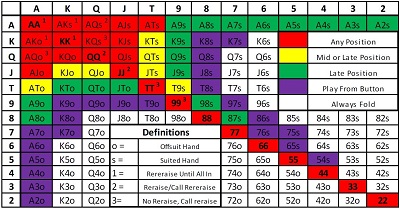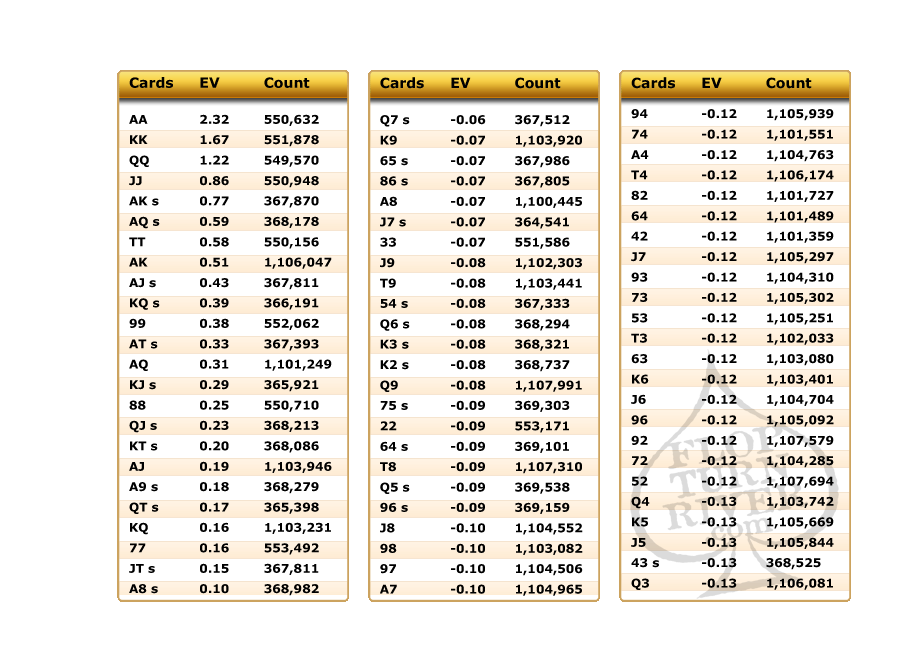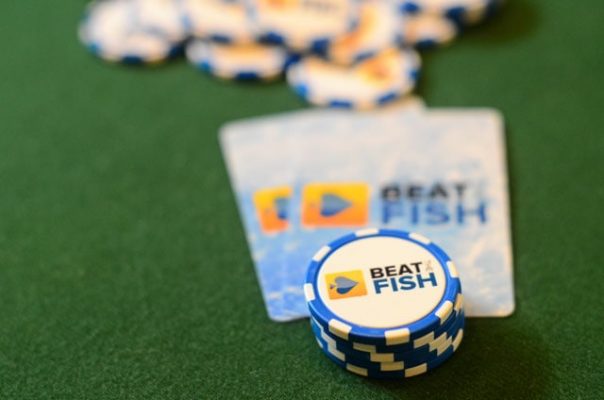- Poker Hand Odds for Texas Hold’em. If you’re playing Texas Hold’em, you have 7 cards to chose your hand from. There are 133,784,560 to deal 7 random cards. This changes the odds and probabilities for all poker hands a bit. Those are the probabilities and odds for all Texas Hold’em Poker hands.
- There’s more: two good playable starting hands in Texas Hold’em don’t usually make even a decent combination in Omaha (eg. You can play A♠ Q♥ and 4♣ 4♦ separately in Texas Hold’em, but playing A♠ Q♥ 4♣ 4♦ in Omaha is not a good idea). Let’s have a look at some different types of starting hands in PLO.
- The probability of being dealt a pair in Texas Hold’em is 5.88%, or odds of 1: 16. There are 13 pairs in Hold’em (22 – AA) and for each there are 6 ways to be dealt. There are 6 different ways to form a specific pair and there are 13 different pairs. Meaning there are unique hole card combinations that are a pair.
Follow these hand charts and learn how to play your starting hands at Texas Holdem.
The chances of getting a top starting hand (of double aces, picture pairs or A-K. Poker Starting Hand Chart (6-Max Cash, 100bb) As such, it’s essential only to raise hands that are going to be +EV to start with (for an open-raise). And thanks to the help of poker solvers like PokerSnowie and PioSolver, we can create a baseline for our 6-Max poker starting hand chart.

The charts below will give you a great starting point on how to play your starting hands. For all of you beginners, we recommend consulting these charts will playing online.
We provide 4 separate charts depending on where you are seated relative to the dealer. You can find out how to play the Blinds, Early Position, Middle Position, and Late Position.
After the flop, you can consult the Drawing Odds Chart at the bottom, but you will also have to develop your reads, pot odds and other skills to develop your post-flop strategies.
Play Texas Holdem at Americas Cardroom! Open a new account and redeem the Americas Cardroom bonus code WELCOME100 for up to a $1,000 bonus!

How to Read the Starting Hand Charts
Let’s look at some examples of how to use these poker odds charts…
| Early Position 88 77 | Unraised Pot Call 1 | Raised Pot Fold |
| * In early position, only call with A8s or 77 if there is already at least one caller in the pot. Fold if you are first in or if the pot has been raised. | ||
| Middle Position 98s | Unraised Pot Call 3 | Raised Pot Fold |
| * In middle position, only call only play 98s if there are already three or more callers. Do not call raises. | ||
| Late Position JJ TT 99 | Unraised Pot Raise 1, Call 2 Raise First In, Call 1 | Raised Pot RR 1 Option, Call All RR or Fold against 1 Player, Call 3 |
| * In late position, you should raise with JJ against one caller or first in, and call against two callers or more. You have the option of rerasing a lone raiser; otherwise, always call a raise. * Raise 99 when you are first in from late position; otherwise, call if the pot has not been raised. If the pot has been raised, you should either re-raise or fold when against a single player, or call if there are three players in the hand. | ||
| Blinds AQs AQ A9s KJ | SB Unraised Pot Raise 1 or 2, Call 3 Call Call | SB Raised Pot RR 1 or 2, Call 3 RR Lone Late, Fold Fold | BB Raised Pot Call (raise 1 or 2 limpers) Call Call 2, or 1 Late |
* In the small blind, you can raise or reraise one or two opponents with AQ, otherwise, call against three or more opponents. * In the small blind, always call A9s against limpers. If the pot has been raised, you should reraise a late position player. You should fold if the raiser is in early or middle position or against two or more opponents. * In the big blind, you can call with KJ against two opponents or a lone late player. Fold against a lone player from early or middle position. | |||
With a little practice, you should be able to find the appropriate poker strategy very quickly. I recommend keeping these charts open to provide guidance as you play. May the odds be with you! – Matthew Hilger
Ready to play some poker? Sign up to Americas Cardroom here!

Get the free Americas Cardroom download at http://pokercasinodownload.com/americas-cardroom-download-bonus-code/
If you also like Video Poker, learn perfect Video Poker strategy at VideoPokerStrategy.org. Check out the Jacks or Better strategy chart at https://videopokerstrategy.org/jacks-or-better-strategy/.
Texas Holdem Hands Percentages
2 4 | |
Related Articles:
Basic Strategy:Tips : Position : Starting Hands : Bluffing : Betting : Money Management

The two cards that you are dealt at the start of a hand in Texas Hold'em are your weapons. If you want to play a hand, your cards need to be strong enough to fight against your opponents' cards to win the pot.
At the core of every winning poker player is good starting hand strategy.
Texas Hold'em starting hands table.
I'm not going to mess about here, I'm just going to give you the starting hand strategy table for you to get your teeth into. The tables below give starting hand recommendations for both full ring and short handed games depending on your position at the table.
How to use the starting hand strategy table.
First thing that you need to do is consider your position in the hand, because this is going to determine the range of cards that you are going to be able to play profitably.
- If you are in early position, you should stick to playing the hands in red only.
- If you are in middle position, you should play the hands in red, as well as the hands in blue.
- If you are in late position, you should play the red and blue hands, along with the hands in green.
So essentially, the better your position is at the table, the more hands you can play.
However, if you are in one of the later positions and there has been a raise before you, then you should forget about playing the hands in green, and stick with the ones in red and blue. This is because players raising from early position will typically have a strong hand, so you should also have a premium hand to play against them. Playing the green hands against a raiser from early position will usually put you in pretty bad shape.
Full ring starting hand strategy.
When you are playing at a full ring table that holds around 10 players, you really need to tighten up your starting hand selection. This is because the large number of players at the table increases the likelihood that at least one player has a premium hand, and so you want to be sure that you have one of the best hands at the table every time you see a flop.
The starting hand table may look to be very strict, but this is simply a rough guide to help beginner players find their feet in Texas Hold'em. After you start to learn the game and become more experienced, you can start to open up your starting hand selection to incorporate different hands in different situations. However, if you are a new player, it is advised that you stick with this table as it will give you the best shot at winning as you start out.
Short handed starting hand strategy.
Seeing as there are less players at the table, you can afford to open up your starting hand requirements quite a bit. If you stuck with the full-ring starting hand table, you would be playing too few hands and missing out on good opportunities to make money.
Short handed tables are going to be harder to play than the full ring tables because the action is generally going to be wilder and less predictable. You are almost forced to play more hands, which means that unless you know what you are doing, the chances are that you are going to lose more money than you would at a full ring game.
Again, just as with the full ring table, the short handed table is merely the basic guide for a beginner player. As you progress, you will be able to work out how to profitably include other starting hands into the line up. But as for now, stick with this table if you're just getting to grips with short-handed play.

Starting hand strategy overview.
If you are a new player, these tables are really going to help set you up in the right direction. Even though this has only been a pretty rough guide on which hands to play in each position, it should have helped to build a solid foundation for you to build upon.
A lot of the time, there are going to be other factors like the type of players who you are up against, and/or the action that has taken place before you that will have an influence on your decision to play a hand. It's always best to use your head in poker, rather than relying on a table or rule for every play you make. So whilst this table will be a handy guide for now, try not to rely on it too much, and start to develop your knowledge of good starting hand strategy as you play.
At the end of the day, poker isn't really poker if you are playing from a set of rules. Always try and use your head when making decisions - they will be more profitable that way.
Go back to the sublime Texas Hold'em guide.
Can You Afford Not To Use
Poker Tracker 4?
Texas Holdem Starting Hands Odds
“I wouldn’t play another session of online poker without it”
“I play $25NL, and in under 1 week PT4 had paid for itself”
Comments